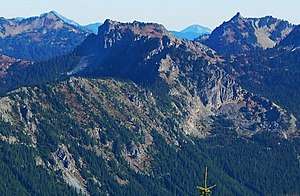Deadwood Peak
Deadwood Peak is a 6,280 feet (1,910 m) summit located on the eastern border of Mount Rainier National Park. It is also on the shared border of Pierce County and Yakima County in Washington state. Deadwood Peak is situated on the crest of the Cascade Range, immediately north of Yakima Peak and Chinook Pass, with the Pacific Crest Trail traversing its east slope. Its nearest higher peak is Naches Peak, 0.59 mi (0.95 km) to the southeast.[1] Deadwood Peak takes its name from Deadwood Lakes[2] and Deadwood Creek[3] to its northwest, and their names came from the large number of downed trees in the area. From Chinook Pass, a short scramble up the south side leads to the summit with unobstructed views of Mount Rainier.
| Deadwood Peak | |
|---|---|
 Deadwood Peak seen from northwest at Sunrise Point | |
| Highest point | |
| Elevation | 6,280 ft (1,910 m) [1] |
| Prominence | 600 ft (180 m) [1] |
| Coordinates | 46°52′54″N 121°31′09″W |
| Geography | |
 Deadwood Peak Location of Deadwood Peak in Washington  Deadwood Peak Deadwood Peak (the United States) | |
| Location | Mount Rainier National Park, Pierce County, Washington, U.S. |
| Parent range | Cascades |
| Topo map | USGS White River Park |
| Climbing | |
| Easiest route | Scrambling class 3 |
Climate
Deadwood Peak is located in the marine west coast climate zone of western North America.[4] Most weather fronts originate in the Pacific Ocean, and travel northeast toward the Cascade Mountains. As fronts approach, they are forced upward by the peaks of the Cascade Range (Orographic lift), causing them to drop their moisture in the form of rain or snowfall onto the Cascades. As a result, the west side of the Cascades experiences high precipitation, especially during the winter months in the form of snowfall. During winter months, weather is usually cloudy, but, due to high pressure systems over the Pacific Ocean that intensify during summer months, there is often little or no cloud cover during the summer. Because of maritime influence, snow tends to be wet and heavy, resulting in high avalanche danger. Precipitation runoff from Deadwood Peak drains west into tributaries of the White River, and east to Yakima River.[1]
See also
Gallery
 Deadwood Peak seen from PCT
Deadwood Peak seen from PCT Deadwood Peak seen from Chinook Pass
Deadwood Peak seen from Chinook Pass Deadwood Peak seen from Deadwood Lakes
Deadwood Peak seen from Deadwood Lakes Deadwood Peak seen from north
Deadwood Peak seen from north_in_Mount_Rainier_National_Park_seen_with_Deadwood_Peak.jpg) Deadwood Lake seen with Deadwood Peak
Deadwood Lake seen with Deadwood Peak Deadwood Peak from Chinook Pass
Deadwood Peak from Chinook Pass
References
- "Deadwood Peak, Washington". Peakbagger.com.
- "Deadwood Lakes". Geographic Names Information System. United States Geological Survey. Retrieved 2018-08-10.
- "Deadwood Creek". Geographic Names Information System. United States Geological Survey. Retrieved 2018-08-10.
- Beckey, Fred W. Cascade Alpine Guide, Climbing and High Routes. Seattle, WA: Mountaineers Books, 2008.
External links
- National Park Service web site: Mount Rainier National Park
- Deadwood Peak photo: Flickr
- National Weather Service Forecast